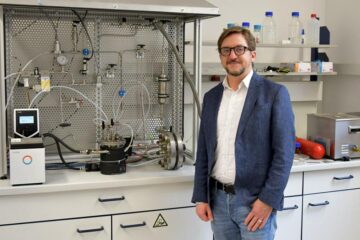Amber waves of grain on a mission to Mars

Mars came nearer to Earth this year than it has in more than 50,000 years, but a new technology could bring it closer still. Scientists have developed a fully sustainable disposal system to deal with waste on long-range space flights using a simple byproduct of wheat.
Wheat grass, an inedible part of the wheat plant, can be used to reclaim pollutants produced from burning waste on a spaceship, according to researchers from Lawrence Berkeley National Laboratory and NASA. The wheat grass itself would normally be trash, but now it can be put to good use in a process that moves the space program one step closer to a manned mission to Mars.
The findings are in the current issue (September/October) of Energy & Fuels, a peer-reviewed bi-monthly journal of the American Chemical Society, the world’s largest scientific society.
A manned mission to Mars has long been a goal of the space program, though it is still just a prospect of the fairly distant future. Such a mission would take about three years, depending on the proximity of Mars in its orbit.
„In these three years, you cannot have a supply from Earth, like in a space station,“ says Shih-Ger Chang, Ph.D., a senior scientist at the Lawrence Berkeley National Laboratory in California and lead author of the paper. „So the key is to develop a way for a sustainable supply of material to the astronauts. They need a fully regenerative life support system because they have to conserve the materials that they carry with them.“
The main problem facing astronauts will be their own „biomass“ — human feces and inedible portions of crops grown for food, such as wheat grass. „If they discard wheat grass or human feces into space, then they throw away nutrients,“ Chang says. „The astronauts need to recover everything for reuse.“
One promising method to deal with this waste is to burn it. Incineration rapidly and completely converts the waste to carbon dioxide, water and minerals, and it is a thoroughly developed technology here on earth. Although plants readily absorb carbon dioxide, the major difficulty with incineration, especially in an enclosed spaceship, is that it produces other pollutants, like sulfur dioxide and nitrogen oxides.
We have effective ways of dealing with these pollutants on Earth but they all require expendable materials, such as activated carbon, which need to be replaced every few months.
And that’s where growing wheat in space comes into play. The inedible portion of the wheat — the wheat grass — can be converted to activated carbon onboard the space vehicle by heating it to about 600 C. Emissions from waste incineration are then sent through the activated carbon, which absorbs nitrogen oxides. These are subsequently recovered and converted to nitrogen, ammonia and nitrates. The nitrogen can be used to replace cabin pressure leakage, while the ammonia and nitrates can be used as fertilizer. When the activated carbon loses its capacity to absorb nitrogen oxides, the process starts over with new wheat grass.
In earlier research, Chang and his colleagues demonstrated that gas from the incineration of biomass contains insignificant amounts of sulfur dioxide, so they focused their efforts in this study on controlling nitrogen oxides.
Wheat for a spaceship can be grown hydroponically — in a nutrient solution exposed to artificial sunlight.
About 203 kilograms of carbon derived from wheat straw could be produced per year, which should be more than enough to sustain a crew of six astronauts, according to Chang’s calculations.
„It’s a recyclable and sustainable process,“ Chang says. The technology is also simple to operate and functional under microgravity conditions.
NASA is planning studies to scale up the process at its Ames Research Center in Moffett Field, Calif.
Media Contact
Weitere Informationen:
http://www.acs.orgAlle Nachrichten aus der Kategorie: Physik Astronomie
Von grundlegenden Gesetzen der Natur, ihre elementaren Bausteine und deren Wechselwirkungen, den Eigenschaften und dem Verhalten von Materie über Felder in Raum und Zeit bis hin zur Struktur von Raum und Zeit selbst.
Der innovations report bietet Ihnen hierzu interessante Berichte und Artikel, unter anderem zu den Teilbereichen: Astrophysik, Lasertechnologie, Kernphysik, Quantenphysik, Nanotechnologie, Teilchenphysik, Festkörperphysik, Mars, Venus, und Hubble.
Neueste Beiträge

Ideen für die Zukunft
TU Berlin präsentiert sich vom 22. bis 26. April 2024 mit neun Projekten auf der Hannover Messe 2024. Die HANNOVER MESSE gilt als die Weltleitmesse der Industrie. Ihr diesjähriger Schwerpunkt…

Peptide auf interstellarem Eis
Dass einfache Peptide auf kosmischen Staubkörnern entstehen können, wurde vom Forschungsteam um Dr. Serge Krasnokutski vom Astrophysikalischen Labor des Max-Planck-Instituts für Astronomie an der Universität Jena bereits gezeigt. Bisher ging…

Wasserstoff-Produktion in der heimischen Garage
Forschungsteam der Frankfurt UAS entwickelt Prototyp für Privathaushalte: Förderzusage vom Land Hessen für 2. Projektphase. Wasserstoff als Energieträger der Zukunft ist nicht frei verfügbar, sondern muss aufwendig hergestellt werden. Das…





















